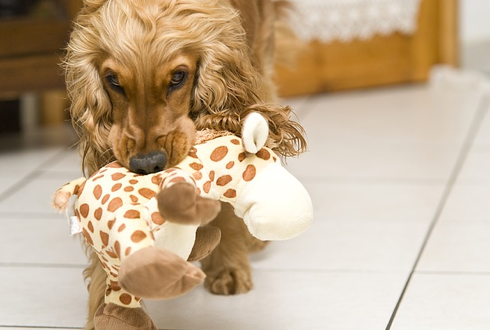
Dog owners generally aren’t aware of what the technical term ‘resource guarding’ means, but most are familiar with what it looks like. This is the dog that acts aggressively to keep something it wants whether that is its food, treats, chew bones, toys, socks, Kleenex, dropped items, or even people. It literally can be anything the dog wants to keep all to itself. It doesn’t matter if it appears to have value to you; it’s whether it has value to the dog. Resource guarding can be aimed at other dogs, other animals like cats, or towards human family members. It is one of the most common types of aggression towards humans in the family.
Is resource guarding related to dominance?
We live in a current dog training society where certain trainers speak extensively on dominance in dogs and what it might look like. It is easy to call resource guarding solely a symptom of dominance in a dog, but that is to highly simplify the issue. Can it appear in dominant dogs? Most certainly. Can it appear it non-dominant dogs? Most certainly.
How is this possible?
The reason why is the behavior is entirely related to the dog just wanting to keep what it has. There can be an element of anxiety in the behavior as the dog can be overly worried about losing his items. There are some dogs that are hyper-sensitive, hyper-vigilant about the behavior at the mere sight of someone. Others don’t react until someone attempts to remove the item from the dog.
The behavior can be seen in dogs that are naturally leader personality type dogs as these dogs generally believe anything should be theirs. They will simply take items from other dogs and if challenged, will growl to keep the item. It can be related to dominance aggression towards people, but you must see this behavior in combination with a lot of other behaviors to make that determination.
The same behavior can also be easily demonstrated by dogs that are easy going and normally well behaved. These dogs will growl at people that attempt to remove items from the dog. It doesn’t mean he’s trying to dominate you. It just means he wants to keep the item.
How might it occur in dogs?
There are a couple of classic ways this behavior can occur:
- Sometimes a dog develops this issue because he has become used to someone taking away things he wants. Imagine a young puppy or dog that repeatedly has items he has run off with, and then someone comes charging after him to take them away. This young dog might decide to try growling to keep the item because he is tired of having it just bullyish taken away. This habit can be created through teasing in a similar manner with children that repeatedly give the dog a toy and take it away and do a lot of teasing with it. Remember, there can be an element of anxiety about having something taken, and if the dog repeatedly has items taken away, his anxiety is validated.
- Some dogs develop this issue early on if they have had to fight to keep things. For example, a small puppy may have to fight to get to eat from much larger siblings or a deprived dog may be feverish to keep something it rarely gets. Many cases of food aggression can revolve around a dog that has been neglected or starved.
No matter how the behavior begins, it can be a very severe behavior in the home. Dogs that exhibit resource guarding are very serious about the task and can deliver a very strong bite. It often draws blood, which surprises many family members on its first occurrence. It is a very serious style of aggression to have in a household with children!
What to do?
The best method to work under is prevention. The problem is people often think repeatedly taking items away from a dog is the best way to prevent the problem, but it’s not. Instead, being fair and trading is the best method. This can also be used if a dog already has the problem.
Here are some key components:
- Don’t stage confrontations or challenges with the dog over items. He will bite you!
- Instead, teach a Trade or Give command where he is fairly encouraged to give items up for something of equal or higher value.
- Teach him that people near him is a good thing when eating or playing with items.
- Don’t do things that encourage the behavior. For example, if he is very aggressive over chew items, don’t give him one that is long-lasting. Instead, provide him with a smaller dental chew that only takes a few minutes to chew, and perhaps he is given the item at bedtime.
- Manage the environment so he isn’t given access to ‘off-limit’ items on a regular basis.
- Have a professional come work with you initially on the training. It can’t be stressed enough how important this is.
